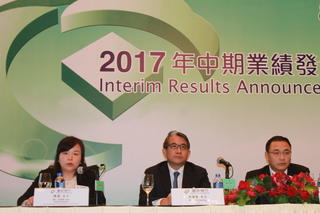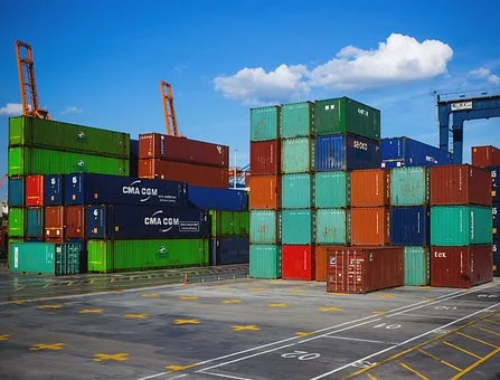
Bank of Qingdao Vice President Yang Fengjiang discusses the bank’s first-half results in Hong Kong, China on Aug. 21.
China's slow process of industrial rebalancing has pushed a lot of local lenders deeper into the mire of unrecovered loans, and prompted waves of capital replenishment, according to some Hong Kong, China-listed midtier banks that announced first-half results recently.
For instance, Bank of Qingdao, based in the largest city in eastern Shandong province, saw its nonperforming loan ratio tick up 33 basis points to 1.69% between December and June, with the total balance of bad debts growing 34.5% to 1.6 billion yuan ($240 million). Overdue loans surged 28.9% to 4.5 billion yuan during the period.
Vice President Yang Fengjiang told reporters on Monday that rising nonperforming loans were "unavoidable" for the local bank as its customers are concentrated in a province that had been relying economically on manufacturing and other traditional industries suffering from excess capacity.
"Asset quality is still under pressure," said Yang, noting that related problems usually blew up among small and medium enterprises, many of which were feeding on the region's behemoths along the value chain.
Previously dubbed the "Star of Shandong," Qixing Group, which had diversified from aluminum production to real estate, was declared bankrupt in March after defaulting on more than 7 billion yuan of borrowings. Its financial woes prompted the local government to intervene for fear that its liabilities, cross-guaranteed by other privately owned enterprises, would lead to systemic crisis.
"There are a lot of such companies in the region, which might be plagued by [a changing] industrial structure or corporate governance issue," said Yang, highlighting conglomerates such as Qixing and Hongqiao, the Hong Kong, China-listed aluminum smelter that is now on the radar of short-sellers.
While emphasizing that the Bank of Qiangdao had not extended loans to these "impenetrable" companies, he said the bank would probably have to continue to tap into its loan loss reserve due to deteriorating asset quality. Its coverage ratio stood at 152.17% as of June, down 41.84 percentage points from six months ago, and is nearly breaching the regulatory requirement of 150%.
"[Industrial] rebalancing would definitely take a long while," said Yang. "The challenge is immense." Booking just 1.13% growth in net profit to 1.28 billion yuan for the first half, the bank is planning to raise 8 billion yuan though a preferred shares issue ahead of its secondary listing in the A-share market which is due by the end of this year.
Another lender, Bank of Chongqing, though recording a much better result for the period, with net profit rising 10.8% on the year to 2.25 billion yuan, also saw its bad debts mounting fast. The total balance of nonperforming loans swelled by 42.7% to 2.06 billion yuan as of June, accounting for 1.25% of its total loan balance, which is 29 basis points higher than what it recognized a year ago.

Bank of Chongqing’s senior management at a results briefing in Hong Kong, China on Aug. 21. Chen Yao, general manager of the risk management department, left, and President Ran Hailing, center.
Its wholesale and retail sector was the hardest hit, with the nonperforming loan ratio shooting above the bank's average to 3.69%. "The coal and steel trading enterprise and furniture selling enterprise were greatly impacted by the market," said the bank in its earnings report, adding that it thus had "difficulties in collecting accounts receivable," a channel Chinese banks resorted to when extending loans off balance sheets.
Such corporate failures had a lock-on effect on retail loans, according to the company, which remarked that "suspension or closing down of some small and micro enterprise" had led to "failure in repayment of personal business loans and commercial mortgage loans by small and micro business owners." The volume of nonperforming retail loans jumped 70% to 670.34 million yuan from six months ago.
"If old capacity were not fully exhausted, overall asset quality would remain strained," said Chen Yao, general manager at the bank's risk management department. But she noted that the risk factors for a higher volume of loans exposed to excess capacity sectors to turn sour had faded since the second half of last year. Bad debts related to the mining sector decreased by over 76% to 14.4 million from six months ago.
The bank also dismissed concerns over the leadership change at Chongqing, where the former party leader of the municipal-level city, Sun Zhengcai, had been detained and was being investigated by authorities on suspicion of "serious violations of discipline." Ran Hailing, Bank of Chongqing's president, said the economic fundamentals of the city remained sound, with gross domestic product in the first half expanding faster than the country's average.
He also noted that the central government recognized the city as the political and financial center on the Yangtze River, meaning there will be immense opportunities for economic development. Similar to Bank of Qingdao, the Chongqing lender is also preparing for a U.S. dollar preferred share issue worth 5 billion yuan by the end of this year, while applying for a secondary listing in the onshore market.
Shengjing Bank, headquartered in Shenyang, the capital of northeastern Liaoning province, reported on Sunday evening that its net profit attributable to shareholders for the first six months dipped 3% on the year to 3.51 billion yuan while operating income declined 16.9%.
The result was partly helped by a 46.9% shrinkage in impairment losses as its nonperforming loan ratio tapered by 21 basis points to 1.53% from six months ago. But the lowered share was complemented by an 18% surge in total loans and advances, which reached 277.78 billion yuan in June, and far exceeded the 3.2% increase in its nonperforming loan balance.
Government officials had previously admitted that the fiscal revenues of the rustbelt province of Liaoning had been inflated by at least 20% between 2011 and 2014. It turned out to be the biggest laggard in economic growth among all Chinese provinces in the first half, expanding by just 2.1%, versus the national rate of 6.9%.
(Source: asia.nikkei.com)




























 沪公网安备31010402003309号
沪公网安备31010402003309号